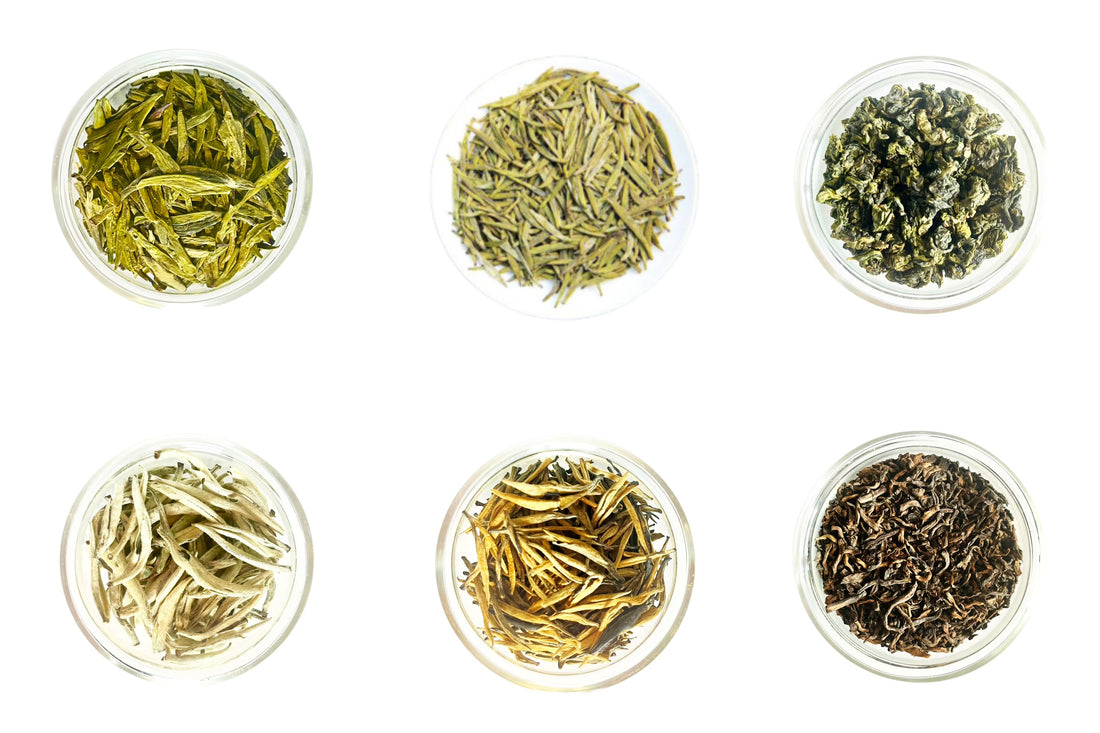
Discover Chinese Tea: 1 Plant, 2 Varieties, 6 Types, Endless Benefits
Share
Tea is more than a drink—it's a way of life, especially in China, where the culture of tea stretches back thousands of years. The concept of “1-2-6” beautifully captures this rich tradition: one plant, two varieties, and six categories of tea. Each type offers unique flavors, health benefits, and cultural significance. Whether you're new to tea or a lifelong enthusiast, there's something here for everyone.
All true teas come from a single plant: Camellia sinensis. From this humble plant grows an incredible diversity of flavors, colors, and benefits—all depending on where and how the leaves are grown and processed.

Two Varieties of Camellia Sinensis
1. Small-Leaf Variety (Camellia sinensis var. sinensis):- Found in subtropical regions and high altitudes.
- Commonly used for green, white, and oolong teas.
- Famous in Zhejiang, Fujian, and Anhui provinces.
- Thrives in tropical climates.
- Known for bold flavors in black and dark teas.
- Grown in Yunnan and parts of India.
Six Types of Tea and Their Benefits
Green Tea
- Processing: Fresh leaves are pan-fried or steamed to retain their green color.
- Benefits: High in antioxidants; boosts metabolism and mental clarity.
-
Key Regions:
- Hangzhou, Zhejiang: Longjing (Dragon Well).
- Anhui: Xinyang Maojian.
- Guizhou and Yunnan: High-altitude green teas.

White Tea
- Processing: Minimally processed; leaves are naturally dried.
- Benefits: Boosts immunity, reduces inflammation, and promotes healthy skin.
-
Key Regions:
- Fuding and Zhenghe, Fujian: Baihao Yinzhen (Silver Needle), Bai Mudan (White Peony), and Shoumei (Longevity Eyebrow).
- Often grown in mountainous areas for optimal quality.

Yellow Tea
- Processing: Lightly fermented with a unique yellowing step.
- Benefits: Gentle on the stomach; aids digestion.
-
Key Regions:
- Junshan Island, Hunan: Junshan Yinzhen.

Oolong Tea
- Processing: Partially oxidized; balances the freshness of green tea and the depth of black tea.
- Benefits: Supports metabolism, aids digestion, and reduces stress.
-
Key Regions:
- Anxi, Fujian: Tieguanyin (Iron Goddess).
- Wuyi Mountains, Fujian: Da Hong Pao (Big Red Robe).
- Guangdong, Chaoshan: Fenghuang Dancong (Phoenix Oolong).
- Taiwan: Dongding Oolong, Dongfang Meiren (Oriental Beauty).

Black Tea
- Processing: Fully oxidized; bold and robust flavors.
- Benefits: Energizes, supports heart health, and is rich in antioxidants.
-
Key Regions:
- Yunnan: Dianhong (Yunnan Black Tea).
- Anhui: Keemun (Qimen Black Tea).
- Fujian: Lapsang Souchong (smoky black tea).

Dark Tea (Pu-erh and Hei Cha)
- Processing: Post-fermented; aged for complex flavors.
- Benefits: Probiotic-rich; improves gut health and digestion.
-
Key Regions:
- Yunnan: Pu-erh tea, the most famous dark tea.
- Sichuan: Ya’an Hei Cha.
- Hunan: Jinghua Fuling, Fuzhuan Hei Cha (Brick Tea).
- Guangxi: Liubao Tea.

Chinese tea represents a perfect harmony of tradition, taste, and health. From the grassy freshness of green tea to the earthy depth of Pu-erh, each type offers something unique. So, whether you're sipping to relax, energize, or connect with tradition, there's a tea waiting to be discovered.
